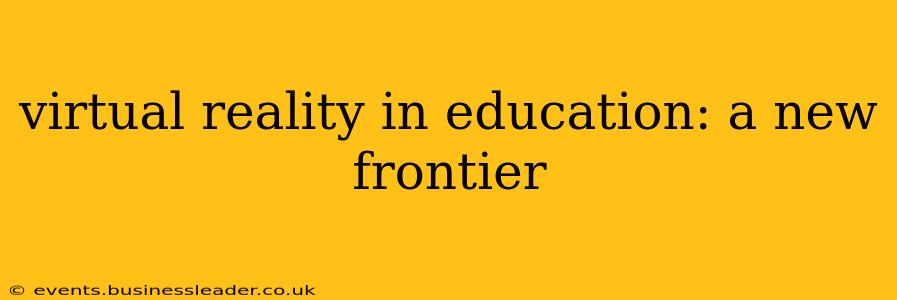Virtual Reality (VR) is rapidly transforming numerous sectors, and education is no exception. This immersive technology offers unparalleled opportunities to enhance learning experiences, making education more engaging, effective, and accessible. From interactive simulations to virtual field trips, VR is poised to revolutionize how we teach and learn. This article delves into the potential of VR in education, exploring its benefits, challenges, and future prospects.
What are the benefits of using VR in education?
The benefits of incorporating VR into educational settings are numerous and far-reaching. Firstly, VR fosters active learning by placing students directly within the learning environment. Instead of passively absorbing information, they become active participants, manipulating objects, exploring scenarios, and solving problems within a virtual world. This active engagement significantly improves knowledge retention and comprehension.
Secondly, VR provides safe and controlled learning environments. Students can practice complex procedures, conduct experiments, or explore dangerous environments without any real-world risks. This is particularly valuable for subjects like medicine, engineering, and the sciences. For instance, medical students can practice surgeries in a virtual operating room, while engineering students can test and refine their designs in a virtual environment before building physical prototypes.
Thirdly, VR enhances engagement and motivation. The immersive nature of VR captures students' attention and stimulates their curiosity, making learning more enjoyable and less daunting. This is especially beneficial for students who struggle with traditional learning methods or find certain subjects uninteresting. The novelty and interactive nature of VR can significantly improve their motivation and overall learning experience.
Finally, VR offers increased accessibility and inclusivity. It can bridge geographical barriers, allowing students in remote areas to access educational resources and experiences previously unavailable to them. It can also cater to students with disabilities, providing personalized learning experiences tailored to their specific needs and learning styles.
What are the challenges of using VR in education?
Despite its considerable potential, integrating VR into education presents several challenges. The high cost of VR equipment is a major hurdle for many schools and institutions, particularly those with limited budgets. The need for specialized hardware, software, and technical support can add significantly to the overall expense.
Furthermore, developing high-quality educational VR content requires expertise and resources. Creating immersive, engaging, and pedagogically sound VR experiences demands significant time, effort, and specialized skills. The creation of effective content that aligns with curriculum standards is crucial to ensure its efficacy.
Another challenge is the potential for motion sickness and other side effects. Some students may experience discomfort or nausea when using VR headsets for extended periods. Careful consideration must be given to the design and duration of VR learning experiences to minimize these risks.
Finally, effective teacher training and support are essential for successful VR implementation. Teachers need to be adequately trained to effectively integrate VR into their teaching practices and to support students who may need assistance or additional guidance while using VR technology. Professional development opportunities tailored to the effective use of VR in education are crucial.
How much does VR equipment cost for education?
The cost of VR equipment for education varies significantly depending on the type of headset, accessories, and software needed. Entry-level VR headsets can be relatively affordable, while high-end systems with advanced features can be quite expensive. Schools and institutions need to carefully assess their budget and educational needs before making a purchase decision. Exploring options for leasing or renting VR equipment might be a more cost-effective approach for some.
How can VR improve student engagement?
VR improves student engagement by transforming passive learning into an active, immersive experience. By placing students inside the subject matter, VR stimulates curiosity and encourages exploration. This heightened level of interaction leads to better understanding, increased knowledge retention, and ultimately, greater enjoyment of the learning process. Furthermore, the gamified aspects of many VR educational applications can significantly improve motivation and encourage collaboration among students.
What are some examples of VR in education?
Numerous applications demonstrate the potential of VR in education. For example, students can take virtual field trips to historical sites, explore the human body in unprecedented detail, or practice complex procedures in a safe, simulated environment. Interactive simulations allow students to experiment with concepts and solve problems in ways that wouldn't be possible in a traditional classroom. Furthermore, VR can be used to create immersive storytelling experiences, bringing history and literature to life in captivating new ways. The possibilities are virtually limitless.
The Future of VR in Education
The future of VR in education is bright. As technology advances and costs decrease, VR is likely to become increasingly accessible and integrated into classrooms worldwide. The development of more sophisticated and engaging VR educational content, coupled with ongoing teacher training and support, will further enhance its effectiveness. We can anticipate even more innovative applications of VR in education, unlocking new possibilities for learning and transforming the educational landscape.
